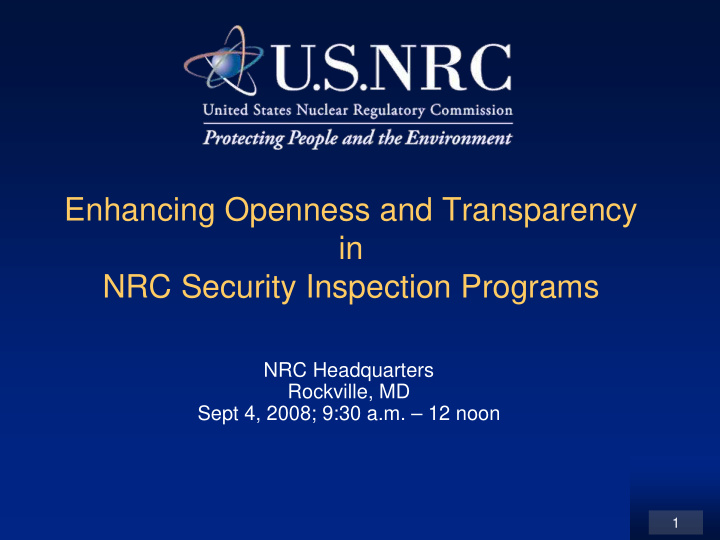



Enhancing Openness and Transparency in NRC Security Inspection Programs NRC Headquarters Rockville, MD Sept 4, 2008; 9:30 a.m. – 12 noon 1
AGENDA • Welcome Patricia “Trish” Holahan, Director Division of Security Operations (DSO) Office of Nuclear Security and Incident Response (NSIR) • Presentation Paul Harris, Senior Program Manager Reactor Security Oversight Branch NSIR/DSO • Discussion, with Questions and Answers 2
Enhancing Public Confidence and Physical Protection Through Effective Openness • NRC has long recognized the importance of protecting the nation by securing nuclear facilities and materials, and we and our stakeholders have significantly enhanced security after the events of 9/11. • This protection was and is accomplished through regulation and inspection, partnership with the nuclear industry, and extensive coordination with other Federal agencies. 3
Balancing Openness and Protection There must be an appropriate balance between the public’s right to information so they can meaningfully participate in regulatory processes and the need to protect sensitive security information from inadvertent release or unauthorized disclosure which might compromise the security of nuclear facilities or materials. 4
Agency- -Wide Openness Wide Openness Agency • Reactors Reactors • • Materials Materials • • Transportation Transportation • • Research & Test Reactors Research & Test Reactors • • Fuel Facilities Fuel Facilities • 5
Types of Information • Unprotected Information (public information) – That which is legitimately in the public domain – That which is not useful for the planning or conduct of a malevolent act or obtaining safeguards or classified information • Protected (controlled information) – Classified Information, including Restricted Data – Safeguards Information – Sensitive Unclassified Security-Related Information (SUNSI) 6
Protected Information - Examples • Information Withholding Mandated by Law, Statute, or Regulation • Classified, Safeguards, Proprietary, Personal, etc. • Inter-Agency Security Information (e.g., FBI, DHS, DOE, etc) • Law Enforcement Sensitive, Critical Infrastructure, etc. • Site-Specific or Generic Vulnerabilities • Structure, System, Design, Impact, or Officer Performance • Details involving aircraft impact design, damage, and mitigation • Any information that could aid in obtaining security-related information or the planning or attempt of hostile acts 7
Why We Could Increase Openness & Transparency 1. Significant Defense in Depth – Robust Structures – Multiple Security Layers – Strong Information Control – Diverse and Redundant Systems – Comprehensive Officer Training and Performance – Effective Command, Control, Communication, and Coordination – Significant Federal, State, and Local Response Capabilities 2. NRC has been conservative in information control following the attacks of September 11, 2001 8
9 Nuclear Power Plant Security
Current Status on Openness • Inspection Report Cover Letters – Provides inspection dates – States the number of findings if of very low significance (i.e., Green) – Acknowledges that there are GTG findings, but not how many – Acknowledges that there was a cross-cutting aspect – States whether the finding is NRC or licensee identified • NRC Web Page – References that security-related information has been removed GTG – Greater than Green 10
Options for Increasing Openness • Provide Additional Detail to Inspection-Related Documents – Annual Report to Congress • Provide description & significance of findings – Inspection Report Cover Letters • Provide the key attribute and/or inspectable area for a finding • Provide the significance of a finding, if Greater-than-Green – Provide public mid-cycle & end-of-cycle security assessments • Enhance NRC Website Information – Provide descriptions of security-related findings – Provide Performance Indicator Results – Provide Inspection Procedures 11
Key Attributes for Security Key Attributes Inspectable Areas Physical Protection Systems Barriers, Alarms, Assessment, and Equipment Performance Access Authorization Personal Screening, Behavior Observation, and Fitness for Duty Access Controls Search and True Identity Response to Contingency Events Protective Strategy and Implementation Material Control and Accounting Physical Inventory, Records, & Procedures Note: The key attribute and inspectable area relating to a finding are not currently public. 12
Considerations and Milestone Considerations 1. NRC already has processes and procedures in place to continue ensuring effective control of sensitive security-related information. 2. NRC staff will proceed cautiously and methodically when implementing any changes. 3. Prior to releasing security-related information, as a minimum, the staff considers whether: (1) the site-specific issue has been corrected; (2) generic considerations exist; and, (3) whether there needs to be an “issuance delay.” Milestone (current projection) January - March 2009 Program changes implemented 13
Summary • Openness and transparency is an Agency-wide effort. • The NRC staff currently believes that the level of openness and transparency can be enhanced; however, stakeholder input is needed to inform any staff recommendation to the Commission. • The NRC is soliciting public comment (via public meetings and a Federal Register Notice ) on the current level of openness and transparency associated with its security inspection program and assessment of licensee security performance. • There must be a proper balance between the public’s right to know and be involved in the regulatory process and the need to prevent disclosure of sensitive security-related information. 14
Recommend
More recommend